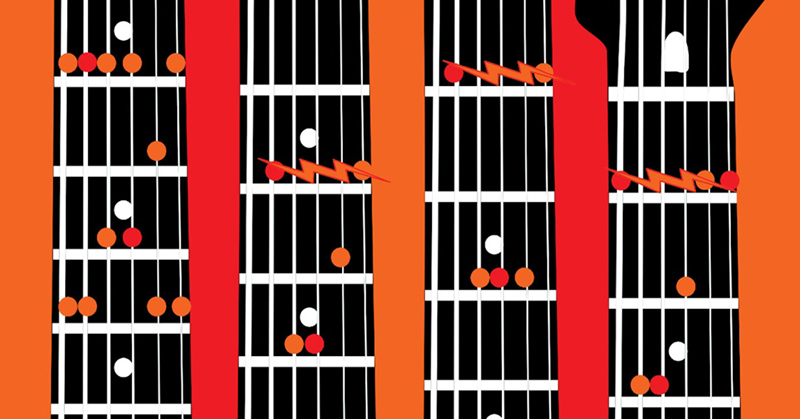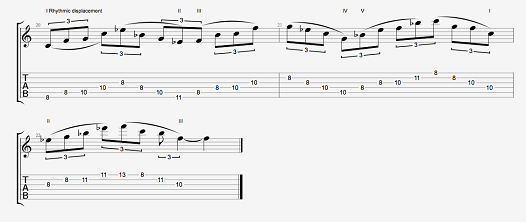
Without variation, practicing scales can be boring and repetitive. But you can quickly fall into more interesting routines, which can impact how you utilize scales when you improvise.
To give you some new ideas about how to practice scales, I suggest patterns. And here's what I mean by that: A pattern is a particular melodic or rhythmic figure played repeatedly. I'll be focusing on the melodic aspect with a scale you're probably already familiar with: the pentatonic minor in first position.
[Related document]: download the Guitar Pro tab for this exercise in both .pdf and .gpx (Guitar Pro 6) formats.
The pentatonic minor is made up of five degrees of the scale: I (tonic), II (minor third), III (fourth), IV (fifth) and VII (minor seventh). The most common way of playing this scale is by moving upwards (or downwards) from one note of the scale to the next. In other words, with each new note we move by one "step." In C minor this gives us C, Eb, F, G and Bb.
1. Now, let's make things interesting by skipping single degrees of the scale. We will call this a "jump."

To illustrate this, a jump from the tonic (the keynote of the scale) would take us straight to IV (the third degree of the scale), skipping the III (the second degree of the scale). A jump from the III (the second degree of the scale) would take us straight to V (the fourth degree of the scale) and so on.

2. By combining these "steps" and "jumps" we create patterns that can be successively used at each degree of the scale. This will enable you to discover unusual ways of using common scales and create original melodic figures. For example, here is a simple three-note pattern consisting of a step following by a jump.

This involves applying the pattern successively, at each degree of the pentatonic scale. The first three-note phrase will begin on the first degree of the scale and will consist of a step followed by a jump (I, III and V). The second will begin on the second degree and will follow the same pattern (III, IV and VII). The next will begin on the third degree (IV, V and tonic), then the next on the fourth degree (V, VII and III), and the fifth on the fifth degree (VII, tonic and IV). Each phrase of the pattern is indicated by a pair of slurs in the score to make it easy for you to distinguish each section.
3. It is also possible to vary the pattern by playing it backwards every other time, or by reversing the order of the notes in other words (on the second degree of the scale, for example, instead of playing III, IV then VII you would play VII, IV then III):

4. Playing the pattern as triplets is a good way to really bring out each of the three-note groups. Changing the duration by switching to sixteenth notes will enable you to create an interesting rhythmic displacement effect. This tends to reduce the repetitive aspect of the pattern by displacing the stresses within the measure.

5. The same effect with the notes played in reverse every other time:

6. Let's move on to a rising four-note pattern consisting of a jump/step/jump sequence. Here are the notes this will give you for each degree of the scale:
I – tonic, IV, V, tonic
II – III, V, VII, III
III – IV, VII, IV
IV – V, tonic, III, V
V – VII, III, IV, VII

7. And now reversing the notes every other time:

8. To rhythmically displace this pattern you simply need to go back to triplets:

It goes without saying that an infinite number of variations are possible. It is simply up to you to experiment with them. It is entirely possible to use double or even triple jumps to add even more variety to the patterns. Depending on the complexity, you may have to use other positions so you can play more easily. Feel free to incorporate legato playing techniques to link two notes played on the same string. By doing this, you will be able to vary the accenting within your melodic figures.
I strongly recommend you practice these patterns with the metronome and vary the tempo so that you are able to easily move from one to the other. Only ascending scale movements are shown in the examples I have provided for you. By using this method with descending movements too, and by making use of all the different elements (patterns, reverse playing and different tempos) in combination, you will be able to significantly improve your phrasing and your melodic vocabulary.
I cannot recommend strongly enough that you extend this kind of practice to the other positions of the pentatonic scale, as well as to any other kinds of scales you find yourself practicing.
I hope you find some patterns to inspire you and keep you occupied throughout the long winter evenings!
Christophe Maerten
Artistic Advisor at Guitar Pro
About Guitar Pro
Guitar Pro is a music software that offers all the features necessary for any guitarist to read and edit their scores/tabs, learn to play songs, and improve their guitar playing. You can find all our guitar lessons at our blog.